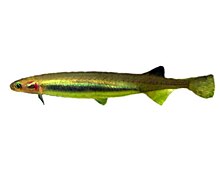Common galaxias
| Common galaxias | |
|---|---|

| |
| Scientific classification | |
| Kingdom: | |
| Phylum: | |
| Subphylum: | |
| Class: | |
| Order: | |
| Family: | |
| Subfamily: | |
| Genus: | |
| Species: | G. maculatus
|
| Binomial name | |
| Galaxias maculatus (Jenyns, 1842)
| |
| Synonyms | |
|
Mesites maculatus Jenyns, 1842 | |
The common galaxias or inanga (Galaxias maculatus), is a species of fish from the galaxiid family that is very widespread in the Southern Hemisphere. It is a slim narrow fish with a forked tail and as an adult it lives in freshwater rivers and lakes. The common galaxias grows to a length of 40 to 120 mm, but can grow up to 180 mm. The English vernacular names used for the species also include cowfish, jollytail, common jollytail, eel gudgeon, inaka, native trout, pulangi, slippery tarki, spotted minnow and whitebait.
Distribution and habitat
Common galaxias are one of the most widely distributed freshwater fish in the world and can be found throughout New Zealand; in coastal streams in south eastern Australia, Tasmania and some parts of southwest Western Australia; in Chile (from 35–55°S); Patagonia, Argentina; in the Falkland Islands; and in some Pacific Islands such as New Caledonia.
Adults are mainly found in still or slow-moving water in the lower parts of coastal streams and rivers, or around the edges of lakes and lagoons. They are often found in small schools, and can tolerate a wide range of natural conditions.
Galaxiid species are, in general, threatened by human activities such as intensive agriculture, dairy, and land change use. These activities have worsened environmental conditions of the river banks (removal of vegetation and nutrient input), leading to eutrophication and subsequent hypoxia. Recent studies have shown that hypoxia imposes a significant challenge for the common galaxias,[2][3][4] forcing them to jump out of the water (emerse) and take up oxygen through their skin as a last resort.[4][5] This response, however, potentially increases the risks of desiccation and predation.
Life history
Unless landlocked within a lake, the common galaxias spawns mainly in autumn during spring tides in the tidally-influenced reaches of rivers and streams.[6] The eggs are laid en masse amongst flooded riparian vegetation and are left stranded as the tide recedes.[6] The eggs remain on the bank (out of the water) until they are the flooded by the next spring tide and stimulated to hatch.[6] The 7 mm long larvae are swept out to sea where they live amongst and feed on plankton for the next 5-6 months. When the juveniles are 50-55 mm in length migrate back into freshwater, and continue migrating upstream until they reach a suitable habitat to develop into the adulthood. As adults they eat insects, crustaceans, and molluscs. This is the same diet as introduced trout, which not only compete for food but also readily eat them. In areas where trout have become naturalised, common galaxias are scarce. Common galaxias, therefore, are mostly found in stretches of streams and rivers that are less suitable for introduced trout.
This species lives for about twelve months and usually dies after spawning.
In New Zealand, Deretrema philippae (=Limnoderetrema minutum) is known to parasitize the intestine (and possibly gall bladder) of the common galaxias. Similarly, the intestinal parasite Steganoderma szidati has been reported from this species' Argentinian population. These are digenean flatworms (Etchegoin et al. 2002).
Fishing
The juveniles are caught as whitebait while moving upstream and are much valued as a delicacy leading to their protection with licensing and controlled fishing seasons in order to preserve adult populations. They are fished commercially in New Zealand, Chile and Argentina, but the last Australian commercial fishery closed in Tasmania in the 1970s.[7]
Some jurisdictions permit fishing of the adults but again under regulation or licence in order to preserve the adult population, but others ban it altogether unless the fisher belongs to an indigenous people (e.g., New Zealand Māori). For instance, in Tasmania, the adult common galaxias may only be caught using a pole of a specified maximum size (one metre).
References
- ^ "Galaxias maculatus". IUCN Redlist. Retrieved 8 August 2015.
- ^ Urbina M.A, Glover C.N., Foster M.E. 2012. A novel oxyconforming response in the freshwater fish Galaxias maculatus. Comparative Biochemistry and Physiology A 161, 301- 06.
- ^ Urbina M.A and Glover C.N. 2012. Should I stay or should I go?: Physiological, metabolic and biochemical consequences of voluntary emersion upon aquatic hypoxia in the scaleless fish Galaxias maculatus. Journal of Comparative Physiology B. 182:1057–1067. doi: 10.1007/s00360-012-0678-3
- ^ a b Urbina M.A, Foster M.E, Glover C.N. 2011. Leap of faith: Voluntary emersion behaviour and physiological adaptations to aerial exposure in a non-aestivating freshwater fish in response to aquatic hypoxia. Physiology and Behavior 103, 240-247.
- ^ Urbina M.A., Meredith, A.S., Forster, M.E. & Glover, C. N. 2014. The importance of cutaneous gas exchange in aquatic and aerial mediums in galaxiid fishes. Journal of Fish Biology, specials issue on Airbreathing fish. 84(3), 759-773.
- ^ a b c McDowall, R.M. (1990). New Zealand Freshwater Fishes: A Natural History and Guide. Auckland: Heinemann Reed. ISBN 0 7900 0022 9.
- ^ Gomon, Martin; Bray, Dianne. "Common Galaxias, Galaxias maculatus". Fishes of Australia. Retrieved 30 August 2014.
- Froese, Rainer; Pauly, Daniel (eds.). "Galaxias maculatus". FishBase. July 2010 version.
- "Galaxias maculatus". Integrated Taxonomic Information System. Retrieved 18 April 2006.
- Etchegoin, Jorge A.; Cremonte, Florencia & Escalante, Alicia H. (2002): Steganoderma (Steganoderma) valchetensis n. sp. (Digenea: Zoogonidae) from the relict fish Gymnocharacinus bergi (Osteichthyes: Characidae) in Argentina. Systematic Parasitology 51(2): 149–153. doi:10.1023/A:1014098732668 (HTML abstract)
External links
- Common Galaxias video
- Native Fish Australia
- http://www.niwascience.co.nz/rc/freshwater/fishatlas/species/inanga NIWA June 2006
- New Zealand ecology - Native freshwater galaxiid fish, Inanga TerraNature, Auckland 2010

